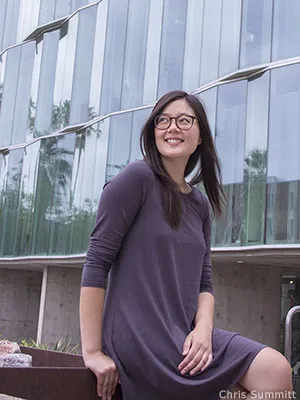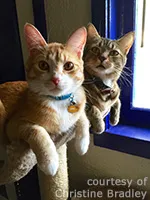Another Wavelength: Christine Bradley

The subject of this month's Another Wavelength column is a familiar face around the halls of the Meinel Building – Christine Bradley earned her B.S. in OSE at OSC in 2011 and is currently a fourth-year graduate student, SOCk officer and president of Women in Optics.
What brought you to optics?
I initially started my undergraduate career as a chemical engineering major but really, I didn’t know what I wanted to do. I wasn’t aware of the optics program and I was lucky that it just presented itself while I attended U of A through internship opportunities. I was involved in an REU program working as an undergraduate research intern starting my first summer in college. I was placed in an analytical chemistry laboratory where I worked closely with their homemade Raman spectrometer. During the summer, I found myself mostly tinkering with the instrument and learning about alignment instead of researching the topic chosen for me (a topic that I don’t really remember other than it involved a fridge full of explosives for explosive detection). It was super fun and I happened to learn quite a bit. It was also through this program that I learned about the optical sciences program and decided to switch.

Who would you call your science hero?
Through all the years of course work, we learn about so many different scientists and mathematicians but there is one, Carl Friedrich Gauss, that will forever stand out to me all due to an awesome physics professor I had for Introduction to Electricity and Magnetism. My professor was going through Maxwell’s equations and introduced Gauss’ flux theorem. We went into much detail about how you would select the proper surface, the Gaussian surface, to make the integral easy. My professor proceeded to say, "Consider you have a dog named Gauss. If Gauss piddles on the floor, you would need to scold him by yelling, 'wrong surface!'" Cheesy jokes aside, I’ve learned over the years that Gauss had his hands in so many different areas including geometrical optics. It amazes me that one person will have such an influence in so many different areas.
Describe your research in 20 words or fewer.
I work closely with a ground-based imaging polarimeter in Professor Chipman’s polarization laboratory studying the polarized reflectance of the Earth’s surface.
Describe your research in 200 words or fewer.
Remote sensing instruments have been designed to acquire information about ecosystem variables and human aerosol contributions. There are many instruments that survey the Earth using various observation modalities such as multispectral, multiangular and polarimetric. Combination of these approaches is useful since the light can originate from numerous sources such as atmospheric scattering due to aerosols and from the Earth’s surface. A top-of-atmosphere instrument viewing downward at the Earth will acquire light in a scene that contains both a signal from the atmosphere and the Earth’s surface.

In order to do useful science, in particular for measurements over land, I have been tasked to study how polarized light will help define the boundary condition layer in order to subtract out the Earth’s reflectance from the data. This will leave the useful aerosol information that can be studied separately. My research has me doing various activities such as modeling and simulation, data analysis, hardware maintenance on the imaging polarimeter, and data acquisition. I’ve spent much time outside on roofs (in Tucson summers!) taking data of different ground surface types and also looking upward to measure scattered light without the Earth in the background.
Also, it’s just fun to have a fancy polarimetric camera. See pic above.

Name three neat facts about you.
- I have two cats, Orson and Hans. They’re babes.
- I like to wear large glasses.
- I tend to collect stark contrast tan lines on my feet.
